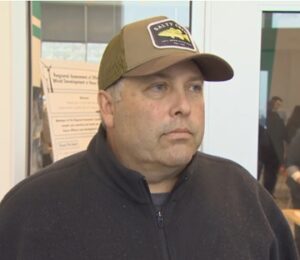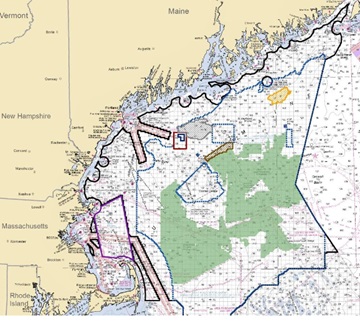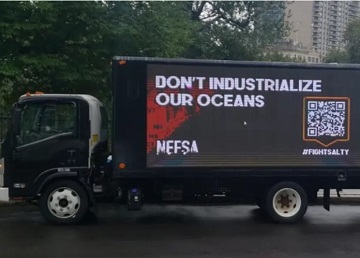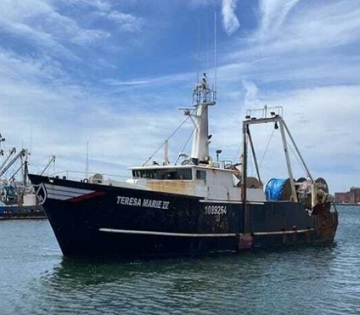Tag Archives: Gulf of Maine

Scallop season is underway
In pitch-black morning, the scallop draggers start heading out Penobscot Bay to be ready one-half hour before the sun rises in Augusta to drop their drags overboard and begin a day’s work. Daylight here already broke the horizon as the scallop fishery opens for the day in the Gulf of Maine. “When the season opens, it’s like the first day of school,” said David Tarr, a scalloper off Naskeag Point and a member of the state’s scallop advisory council. Now two weeks into the season, and Tarr says, “I think it’s been a good opening. Boats are keeping local. Whether dragging or diving, the daily limit is 15 gallons of meat that sells anywhere from $12 to $23 per pound, depending on its size. 8 photos, more, >>click to read<< 07:55

Lobstermen watching closely as federal regulators refine area for potential offshore wind
Lobster fishermen are watching closely as regulators continue to refine an area in the Gulf of Maine that could be used for offshore wind development, and they’re looking for more reassurances that the federal government will avoid popular fishing grounds. The federal Bureau of Ocean Energy Management has identified a 3.5 million acre draft area off the coasts of Maine, New Hampshire and Massachusetts that could be used for commercial offshore wind development. That proposed area excludes most of Lobster Management Area (LMA) 1, a popular offshore fishing area in Maine. But Zach Jylkka of the Bureau of Ocean Energy Management said some fishing grounds near or part of LMA 1 are still being studied and may be up for consideration, because they would be less expensive to develop. >>click to read<< 21:50

Fishermen in Maine lobbied to keep wind farms out of crucial fishing grounds. Will it happen in N.S.?
A no-compromise lobbying campaign by Maine lobster harvesters has helped keep wind farms out of a crucial lobster fishing area in the Gulf of Maine. And that has some fishermen in Nova Scotia casting an envious eye south of the border. “I’m pleased to see that happen in Maine. We’d like to see the same sort of diligence taken in Nova Scotia,” said Tommy Amirault, a fisherman from Pubnico and president of the Coldwater Lobster Association. “Maine obviously has concerns. It would be nice to  see both provincial and federal governments take our concerns into practice,” Amirault said. “We didn’t mince words that we opposed offshore wind anywhere in the Gulf of Maine. It’s one of the most productive ecosystems in the world. And we really didn’t think that this is the place to solve the renewable energy crisis,” said McCarron. In Nova Scotia, the process has just begun. He said it’s no surprise fishermen have concerns about where it happens. >>click to read<< 06:57
see both provincial and federal governments take our concerns into practice,” Amirault said. “We didn’t mince words that we opposed offshore wind anywhere in the Gulf of Maine. It’s one of the most productive ecosystems in the world. And we really didn’t think that this is the place to solve the renewable energy crisis,” said McCarron. In Nova Scotia, the process has just begun. He said it’s no surprise fishermen have concerns about where it happens. >>click to read<< 06:57
House Republicans rebuff move by Golden to block offshore wind in Gulf of Maine lobster area
 Majority Republicans in the U.S. House of Representatives rejected an attempt by Rep. Jared Golden, D-Maine, to use federal spending to block offshore wind development in a lobster fishing area of the Gulf of Maine. Golden, who tried to amend 2024 appropriations legislation for the Department of Interior, said he will try again to bar offshore wind development in what’s known as Lobster Management Area 1. His measure sought to prevent funding to lease, license, permit or provide any authorization to develop offshore wind energy that could jeopardize lobster fishing. “Offshore wind development in the Gulf’s most productive fishing grounds is a threat to Maine fishermen’s way of life,”>>click to read<< 07:28
Majority Republicans in the U.S. House of Representatives rejected an attempt by Rep. Jared Golden, D-Maine, to use federal spending to block offshore wind development in a lobster fishing area of the Gulf of Maine. Golden, who tried to amend 2024 appropriations legislation for the Department of Interior, said he will try again to bar offshore wind development in what’s known as Lobster Management Area 1. His measure sought to prevent funding to lease, license, permit or provide any authorization to develop offshore wind energy that could jeopardize lobster fishing. “Offshore wind development in the Gulf’s most productive fishing grounds is a threat to Maine fishermen’s way of life,”>>click to read<< 07:28
Delano: Biden administration won’t leave lobstermen alone
 Lawmakers and a federal appeals court last year defeated a federal plan to save endangered whales by eradicating New England’s lobster industry. With those plans undone, the National Oceanic and Atmospheric Administration (NOAA) is crafting a workaround scheme to regulate lobstermen out of the fishery. Recent years have been brutal going for lobstermen, such that the survival of our trade is highly uncertain. Lobstermen are at once negotiating higher fuel costs, higher bait costs, higher shipping costs, and an agitation campaign from dark money nonprofits trained on major buyers of Maine lobster products. NOAA’s new regulatory plan is poised to decimate our inventory. >>click to read<< 09:18
Lawmakers and a federal appeals court last year defeated a federal plan to save endangered whales by eradicating New England’s lobster industry. With those plans undone, the National Oceanic and Atmospheric Administration (NOAA) is crafting a workaround scheme to regulate lobstermen out of the fishery. Recent years have been brutal going for lobstermen, such that the survival of our trade is highly uncertain. Lobstermen are at once negotiating higher fuel costs, higher bait costs, higher shipping costs, and an agitation campaign from dark money nonprofits trained on major buyers of Maine lobster products. NOAA’s new regulatory plan is poised to decimate our inventory. >>click to read<< 09:18

BOEM Announces Gulf of Maine Draft Wind Energy Area Meetings for Fishing Community
This notice is being sent as a courtesy to help raise awareness of a comment opportunity and public meetings being held by the Bureau of Ocean Energy Management (BOEM) regarding a Draft Wind Energy Area (WEA) in the Gulf of Maine. It is critically important that members of the fishing industry comment on this proposal.nDMR also encourages fishing industry members to click on this link to read the statement from Governor Mills and Maine’s Congressional Delegation, expressing opposition to inclusion of draft WEAs in LMA1. On October 19, 2023, BOEM announced a Draft Wind Energy Area (Draft WEA) in the Gulf of Maine and an accompanying 30-day public comment period. The Draft WEA covers around 3.5 million acres offshore Maine, Massachusetts, and New Hampshire, ranging from 23-120 miles off the coast. BOEM invites you to attend virtual public meetings where BOEM will outline the data and the information used to inform the Draft WEA and provide opportunity for feedback from the fishing community and public-at-large. Lots of links and info, >>click te read<< 15:31

Maine Lobstermen Win Giant Carveout From Offshore Wind Development Area
The U.S. Bureau of Ocean Energy Management (BOEM) is rolling out designated offshore wind leasing areas off the lower 48 states at a rapid clip, racing to meet the Biden administration’s target of 30 gigawatts of capacity by 2030. For the latest – a 3.5 million acre parcel in the Gulf of Maine – it has decided to dodge a looming fight with fishing and environmental interests. The newly-released Draft Wind Energy Area for the Gulf of Maine has enough room for up to 40 gigawatts of offshore wind capacity, with a focus on floating wind installations in deeper water. The size is notable, but the most conspicuous part is the part that was left out: Lobster Management Area 1, a strip along the coast that is essential to the powerful Maine lobster industry. >>click to read<< 09:08

From the Gulf of Maine to a tin can: A glimpse into high-end tuna production on NH’s coast
“I left today at, like, 12 midnight,” he said, his face hidden behind mirrored sunglasses and a beard. “And then it’s about an hour and a half ride out, and it was beautiful last night because that big fat moon is waning.” Keper Connell is a one-man operation aboard his boat, The Figment. When conditions allow, he cruises into the Gulf of Maine in search of bluefin tuna, a torpedo-shaped fish that can reach more than 1,000 pounds. Rather than sell his bluefin to a wholesaler, where cuts may end up in a fishmonger’s display case, or as toro on a sushi menu, Connell is doing something that nobody else in the U.S. is apparently doing. His fish is put on ice and sent to Oregon, where it will be packed into tin cans with a high end olive oil and some salt. (There are no canneries on the East Coast where an independent fisherman can bring his catch, he says.) Photos, >>click to read<< 11:07
Fishermen slam Biden admin’s offshore wind push as threat to jobs, sea life
 The New England Fishermen’s Stewardship Association (NEFSA) on Monday released an Offshore Wind Research Summary, a compilation of scholarly articles that identify dangers offshore wind farms pose to ocean ecosystems. “We cannot industrialize the Gulf of Maine until we understand how the wind industry interacts with the fisheries that wild harvesters have stewarded responsibly for decades,” said Jerry Leeman, NEFSA CEO and a longtime commercial fishing captain. Leeman says that the government’s attempt to justify wind farms leans on “voodoo science” because the proper methods and sufficient amount of time have not been applied. “The problem is the science that wraps around the science, the whole purpose for it is misinterpreted to the public through the fact that they think they’re getting real, accurate science,” Leeman said. >click to read<
The New England Fishermen’s Stewardship Association (NEFSA) on Monday released an Offshore Wind Research Summary, a compilation of scholarly articles that identify dangers offshore wind farms pose to ocean ecosystems. “We cannot industrialize the Gulf of Maine until we understand how the wind industry interacts with the fisheries that wild harvesters have stewarded responsibly for decades,” said Jerry Leeman, NEFSA CEO and a longtime commercial fishing captain. Leeman says that the government’s attempt to justify wind farms leans on “voodoo science” because the proper methods and sufficient amount of time have not been applied. “The problem is the science that wraps around the science, the whole purpose for it is misinterpreted to the public through the fact that they think they’re getting real, accurate science,” Leeman said. >click to read<
Fishermen’s Alliance Highlights Offshore Wind Threat to Haddock, Lobster Fisheries in Gulf of Maine
 An alliance of groups representing New England’s fishermen is highlighting scientific research that suggests offshore wind development could have “population-scale effects” on key fish and crustacean species in the Gulf of Maine, including electromagnetism-induced deformities in lobsters. The New England Fishermen’s Stewardship Association (NEFSA) on Monday released an “Offshore Wind Research Summary” summarizing the existing scientific research on the environmental impact of offshore wind power development. The scientific evidence, they believe, shows that offshore wind development would have unpredictable and potentially harmful consequences for key marine species, such as lobster and haddock. >click to read< 17:37
An alliance of groups representing New England’s fishermen is highlighting scientific research that suggests offshore wind development could have “population-scale effects” on key fish and crustacean species in the Gulf of Maine, including electromagnetism-induced deformities in lobsters. The New England Fishermen’s Stewardship Association (NEFSA) on Monday released an “Offshore Wind Research Summary” summarizing the existing scientific research on the environmental impact of offshore wind power development. The scientific evidence, they believe, shows that offshore wind development would have unpredictable and potentially harmful consequences for key marine species, such as lobster and haddock. >click to read< 17:37

Leeman: Maine must hit pause on offshore wind turbines
You wouldn’t buy a house without an inspection, so why would we fill the Gulf of Maine with wind turbine superstructures without understanding how they interact with the marine environment? Offshore wind energy features too many unknowns to proceed at this point with widescale ocean industrialization. That’s why my organization, the New England Fishermen’s Stewardship Association (NEFSA) has joined with partner organizations to call on state and federal authorities to reset our renewable energy policy. The state of Maine is developing a floating offshore wind research array at a 15-square-mile site in the Gulf of Maine. >click to read< 08:17

NOAA Fisheries Announces Common Pool Area Closure for Gulf of Maine Cod
Effective at 4:15 pm on July 27, 2023 – Statistical areas 513 and 514 are closed for the remainder of Trimester 1, through August 31, 2023. This closure applies to all common pool vessels fishing on a groundfish trip with trawl, sink gillnet, or longline/hook gear, including handgear vessels. The closure is required because 90 percent of the Trimester 1 Total Allowable Catch (TAC) for Gulf of Maine (GOM) cod has been caught. This area will reopen at the beginning of Trimester 2, at 0001 hours, September 1, 2023. >click to read< 12:58

Maine Fishermen, scientists find flaws in potential wind energy lease areas
BOEM officials called the meeting to review newly released draft maps of where federal leases could be offered in the Gulf of Maine, known as the “call” area. They wanted fishermen’s feedback to see where the maps fell short based on what fishermen know from working on the water. “This is very difficult for our industry to face,” said Dustin Delano, New England Fishermen Stewardship’s chief operating officer, former vice president of the Maine Lobster Association and a fourth-generation lobsterman out of Friendship. “A lot of us feel this is going to wipe us off the map.” The fishermen present were unconvinced but resigned. >click to read< 07:55

Meet the Women Making Waves in Maine’s Tough Lobster Industry
When Krista Tripp was 18, she’d completed all of the hours at sea necessary to get her captain’s license, but her parents submitted her brother’s paperwork to the State of Maine and not hers. Why? Even though Krista had been hauling traps since she was eight years old and running her own boat since 15, the expectation was that now she’d settle down and start having babies. “My brother and I shared the boat, we had 150 traps, and I became obsessed at an early age,” Tripp recalls. “I knew that was what I wanted to do. But, as a girl, my parents didn’t really take me seriously.” Tripp would spend the next few years working as a sternman off of a scallop boat in Massachusetts. Eventually, she returned to Maine, and after 14 years, she got herself off the waiting list and became the captain of her own lobster boat. Today, she has been captaining her own lobster boat for more than eight years. Photos, >click to read< 14:23

Proposal before Maine lawmakers would jumpstart offshore wind projects
Maine is poised to launch an offshore wind program that would meet clean energy goals and produce enough power for about 900,000 homes from floating wind turbines in the Gulf of Maine. The bill was revised after a veto by Democratic Gov. Janet Mills to ensure non-union companies can get into the business, setting a path to approval by the Maine Senate and House on Tuesday. Approval would put Maine on a path to catch up with other states that already have offshore wind projects. It also includes incentives aimed at ensuring wind power developers steer clear of lucrative lobster fishing grounds. The bill’s sponsor, Sen. Mark Lawrence, D-York, said he believes the compromise bill has necessary “guardrails in place to make sure this is done right and truly benefits Mainers.” >click to read< 11:23

Gloucester Fishing industry reps raise concerns about wind energy areas
Commercial fisherman Al Cottone, executive director of the Gloucester Fisheries Commission, and Angela Sanfilippo, executive director of the Massachusetts Fishermen’s Partnership and president of the Gloucester Fishermen’s Wives Association, outlined the fishing industry’s concerns with offshore wind development. “First of all the construction process, the areas that are going to be used will probably be lost forever for commercial fishing,” Cottone said. “There are going to be a lot of losers when it comes to activity within these areas. You are not going to be able to find an area to put these arrays where someone is not going to lose their ability to fish and make a living,” Cottone said. He said this was a critical time for the local fishing industry. >click to read< 07:46

BOEM Schedules In-Person Informational Meetings on Offshore Wind in the Gulf of Maine
BOEM invites you to attend in-person meetings in Massachusetts, New Hampshire, and Maine in July 2023. BOEM is seeking feedback and local knowledge from the Gulf of Maine fishing community to facilitate improvements in spatial models used to inform draft Wind Energy Areas in the Gulf of Maine. The in-person meetings will provide opportunities to meet with BOEM staff, learn about the data BOEM has received for the models, and provide feedback on how their spatial models are incorporating the data. The meetings will include a mixture of small-group conversations and plenary speakers. Additional opportunities to comment will be available after the meetings. >click for schedule and locations< 16:49

Haddock quotas for fishermen have been drastically cut. What does that mean for haddock eaters?
There is a haddock problem swimming around Gulf of Maine waters. But don’t blame the problem on fishermen catching too many haddock, say Maine commercial fishing advocates like Ben Martens, executive director of the Maine Coast Fishermen’s Association. In fact, they have been fishing in accordance with mandated quotas for decades, he said, regulatory measures that have returned the haddock stocks in the Gulf of Maine to sustainable levels. The problem, rather, is grounded in inaccurate accounting of the boom-and-bust cycles of haddock biomass, that is, how many fish are swimming in the Gulf of Maine at any given time. In April, the New England Fishery Management Council, a regional body that uses industry and scientific data to recommend quotas that restrict how many metric tons of regulated species Maine fishermen can haul in each year, announced a cut in haddock quotas. It represents an 80 percent reduction in allowable catch; the new season began on May 1. >click to read< 08:50

How I met a slime star: A rare and slimy encounter in the Gulf of Maine
Back in 1993, a friend called and asked me about an article he had read in the June issue of the National Geographic about a weird animal called a slime star. He wanted to know if I had ever seen one and if they are found in New England. I told him I had never seen one and that I believed they are found in the Pacific, not the Atlantic. Less than a month later, I was proved wrong! My husband had been fishing on his stern trawler in about 420 feet of water near the “Curl” on Jeffreys Ledge in the Gulf of Maine. He called me and told me he had something odd in his lobster tank. I asked him to describe it to me. He said that it was giving off gallons and gallons of mucus. Photos, >click to read< 12:08

What’s behind the surge of blue, orange and calico lobsters in the Gulf of Maine?
If you have been to the Oceanarium at Hampton Beach, you know that we usually have some odd-looking lobsters. We currently have an orange, a blue, a calico, and a normal-colored lobster in our tanks. The question is always: How rare are these animals? The answer has gotten more and more murky as the years pass. The color of lobsters can be due to several things. Diet can cause them to be less vivid or more yellow from eating certain seaweeds. Shell disease can cause them to be spotted and appear to be calico. The color can also be caused by a genetic mutation, which affects the proteins in their exoskeleton. photos, >click to read< 10:53

U.S. Rep. Jared Golden introduced a bill in Congress that would prevent offshore wind development in key fishing area
The bill would prevent the federal Bureau of Ocean Energy Management from potentially hurting the fishing and lobstering industries in Maine, said Golden, D-2nd District. The legislation also would launch an assessment of how federal agencies like the BOEM and the National Marine Fisheries Service study the effects of offshore wind development and engage with industry groups. Lobster Management Area 1 is the zone closest to the shores of Maine and stretches along the entire coast. That’s where Virginia Olsen, a commercial lobsterman and director of the Maine Lobstering Union, says a majority of Maine fishing and lobstering is concentrated. “I think this is the exclusion zone that the Maine Lobster Union and the area that the (Maine Lobstermen’s Association) would agree is most important economically to the fishery,” Golden said. >click to read< 19:46

Fishermen To Replace NOAA With NEFSA Due to Reliance on Inaccurate Data to Set Catch Quota
NOAA which has the task of managing and safeguarding the nation’s marine resources, sets catch quotas to ensure sustainable fishing practices annually. However, it has been discovered from an investigation that the agency uses heavily outdated and incomplete information to estimate its fish and marine life population, and subsequently set fish catch quotas’ sets quotas for particular species based on data it collects from its research vessels. NOAA’s research vessel for the Northeast and the Mid-Atlantic is the Henry B. Bigelow, homeported in Newport, Rhode Island, U.S.A. A group called the New England Fishermen Stewardship Association (NEFSA), a new coalition of lobstermen, fishermen, and fishing-adjacent businesses was formed as a replacement due to the reported drawbacks of NOAA. >click to read< 10:5

Maine Delegation, Gov. Mills asks BOEM to listen to fishermen, remove LMA1 from wind power planning

Haddock stock decline prompts catch limits
A low New England haddock stock has prompted regulators to cut the fishing quota of one of the region’s most popular fish. A staple in fish and chips and for fish burgers and home cooks, the amount available from the Gulf of Maine and Georges Bank for 2023 will be more than 80 percent less than the previous year. Prices are relatively high for shoppers, too, with Hannaford, Shaw’s and local fish dealers asking anywhere from $11.99 to $14.99 per pound this month for wild caught Gulf of Maine haddock. Haddock is “subject to overfishing” in the Gulf of Maine while the Georges Bank stock is not, according to NOAA Fisheries. >click to read< 19:02

Role of Unionized Firms at Center of Maine’s Offshore Wind Debate
On Thursday the Maine Legislature’s Energy, Utilities and Technology Committee held a public hearing on a proposal to pave the way for the development of offshore wind infrastructure in the Gulf of Maine, including the construction of a coastal manufacturing facility that would build the offshore floating wind turbines Lawmakers also considered Thursday Rep. Tiffany Strout’s (R-Harrington) LD 1884, a bill that would block offshore wind developments. In recent years, the prospect of filling the Gulf of Maine with hundreds of wind turbines has taken on an air of inevitability, with environmental groups, industry groups, and well-paid lobbyists pouring millions of dollars into political pressure campaigns and ad campaigns designed to build support for the project. Unions, construction companies, investment companies, and lobbyists are all lining up to secure their share of what could be one of the largest taxpayer-funded projects in the history of the state. >click to read< 09:42

NEFMC asking NOAA to increase catch limit for haddock in Gulf of Maine to protect fishermen
In a statement issued April 20, the New England Fishery Management Council, which oversees fishing issues for the region, said the catch limit for the season that began May 1 is 1,936 metric tons, an 84 percent drop from last year. But now the council wants to give fishermen a reprieve, citing a rebound in haddock stock and after hearing concerns at the panel’s meeting last month in Mystic, Conn. “Fishermen have been encountering Gulf of Maine haddock at very high catch rates,” the council said, adding that several fishermen voiced concern “that an early shutdown of the fishery was highly likely and would have wide-ranging impacts.” “Even without targeting haddock, fishermen need haddock quota to account for bycatch while harvesting other species,” the council said. >click to read< 09:43

Mega Cut: Haddock, a staple Atlantic fish, is in decline off New England, regulators say
A recent scientific assessment found that the Gulf of Maine haddock stock declined unexpectedly, and that meant the catch quotas for the fish were unsustainably high, federal fishing managers said. “We seem to find plenty, but they can’t,” said Terry Alexander, a Maine-based fisher who targets haddock and other species. “It’s a disaster is what it is. A total, complete disaster.” The fishery management council mandated the 84% reduction in catch quotas for the current fishing year, which started May 1. The change applies to fishers who harvest haddock from the Gulf of Maine, a body of water off Massachusetts, New Hampshire and Maine. Fishers also harvest from Georges Bank, a fishing ground to the east where quotas were also reduced for this year, including adjoining areas overseen by Canadian officials who issued their own major cuts. >click to read< 08:02

Environmental Regulations and Wind Turbines Are Backing New England Fishermen into a Corner
Just three weeks ago, Jerry Leeman was a commercial fishing captain in New England and a very successful one at that. Now, as executive director of the newly formed New England Fishermen Stewardship Association, he’s leading the charge against Biden administration policies that threaten the industry he loves, including overregulation and wind-turbine development in the Gulf of Maine. Leeman said that he and fellow New England fishermen have serious concerns about the accuracy of the NOAA data. Fish-population assessments fell to the wayside during the Covid years — 2021 and 2022 — and the data-collection process has not yet been corrected. “Whether you’re a lobsterman or a ground fisherman, a trend up and down the coast here is that nobody wants wind turbines placed in our environment. It’s going to mess up our stocks and our species. Not to mention it’s going to change the viability for generations to come in the fishing grounds,” Leeman said. Photos, >click to read< 07:51

Clearwater Seafoods wants 72 tonnes of lobster added to its annual harvesting quota
The Indigenous-owned company has exclusive rights to Lobster Fishing Area 41, or LFA 41, off southern Nova Scotia, where Clearwater maintains a long-held quota of 720 tonnes. Last fall, the Membertou First Nation and Mi’kmaw partners in the company asked the Department of Fisheries and Oceans to increase the total allowable catch by ten per cent. In response, DFO has issued an “interim” total allowable catch of 720 tonnes for 2023 while it considers this request. The Brazil Rock Lobster Association, the Coldwater Lobster Association and the LFA 33 Advisory Committee have submitted letters to DFO in opposition. >click to read< 08:44













































Fishermen submit hundreds of comments on leasing Gulf of Maine for offshore wind
During the 33-day comment period, BOEM held six online meetings Nov. 1-3 to discuss the draft areas and three proposed secondary areas not included in the draft, and to answer questions and hear feedback from specific stakeholder groups, such as commercial and recreational fishermen, environmental nonprofits and the shipping and transportation sector. So, what did everyone have to say? When it comes to commercial fisheries, gaps in the data that inform where WEAs will least conflict with fishing remain a top concern, as do the cables running the power to shore. Also of concern are certain quadrants included in the draft WEAs, which some at the meetings said are spawning areas for haddock and redfish. more, >>click to read<< 08:27
Share this post